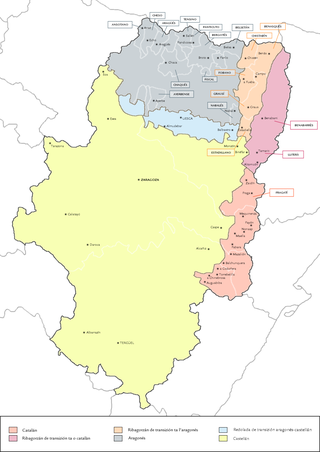| Aragonese | |
|---|---|
| aragonés | |
| Pronunciation | [aɾaɣoˈnes] |
| Native to | Spain |
| Region | Aragon; northern and central Huesca and northern Zaragoza |
| Ethnicity | Aragonese |
Native speakers | Active speakers: 10,000–12,000 (2017)[1] Active and passive speakers: 30,000–50,000 (2017)[1] |
Early forms | Old Latin
|
| Dialects |
|
| Latin (Aragonese alphabet) | |
| Official status | |
Recognised minority language in | |
| Regulated by | Academia d'a Luenga Aragonesa |
| Language codes | |
| ISO 639-1 | an |
| ISO 639-2 | arg |
| ISO 639-3 | arg |
| Glottolog | arag1245 |
| ELP | Aragonese |
| Linguasphere | 51-AAA-d |
 Map of Aragon with the dialects of northern Aragon in grey, blue, and light orange | |
 Aragonese is classified as Definitely Endangered by the UNESCO Atlas of the World's Languages in Danger (2010) | |

Aragonese (/ˌærəɡəˈniːz/ ARR-ə-gə-NEEZ; aragonés [aɾaɣoˈnes] in Aragonese) is a Romance language spoken in several dialects by about 12,000 people as of 2011, in the Pyrenees valleys of Aragon, Spain, primarily in the comarcas of Somontano de Barbastro, Jacetania, Alto Gállego, Sobrarbe, and Ribagorza/Ribagorça.[1][2] It is the only modern language which survived from medieval Navarro-Aragonese in a form distinct from Spanish.
Historically, people referred to the language as fabla ('talk' or 'speech'). Native Aragonese people usually refer to it by the names of its local dialects such as cheso (from Valle de Hecho) or patués (from the Benasque Valley).
- ^ a b c Perez, R. (2017-02-21). "El aragonés: la lengua romance que ya solo hablan el 1% de los aragoneses" [Aragonese: the Romance language that already only 1% of Aragonese speak]. ABC (in Spanish). Retrieved 14 January 2020.
- ^ Reyes, Anchel; Gimeno, Chabier; Montañés, Miguel; Sorolla, Natxo; Esgluga, Pep; Martínez, Juan Pablo (2017). L'aragonés y lo catalán en l'actualidat. Analisi d'o Censo de Población y Viviendas de 2011 (in Aragonese). Zaragoza. ISBN 978-84-16723-25-6 – via zaguan.unizar.es.
{{cite book}}: CS1 maint: location missing publisher (link)